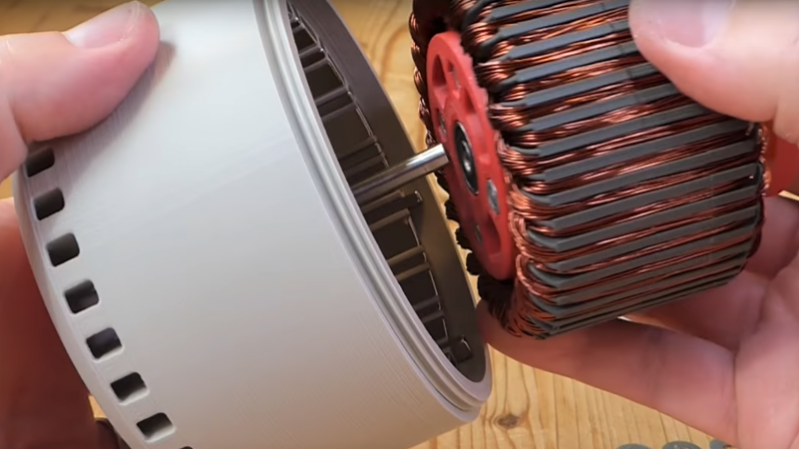Not satisfied with the specs of off-the-shelf brushless DC motors? Looking to up the difficulty level on your next quadcopter build? Or perhaps you just define “DIY” as rigorously as possible? If any of those are true, you might want to check out this hand-wound, 3D-printed brushless DC motor.
There might be another reason behind [Christoph Laimer]’s build — moar power! The BLDC he created looks more like a ceiling fan motor than something you’d see on a quad, and clocks in at a respectable 600 watts and 80% efficiency. The motor uses 3D-printed parts for the rotor, stator, and stator mount. The rotor is printed from PETG, while the stator uses magnetic PLA to increase the flux and handle the heat better. Neodymium magnets are slipped into slots in the rotor in a Halbach arrangement to increase the magnetic field inside the rotor. Balancing the weights and strengths of the magnets and winding the stator seem like tedious jobs, but [Cristoph] provides detailed instructions that should see you through these processes. The videos below shows an impressive test of the motor. Even limited to 8,000 rpm from its theoretical 15k max, it’s a bit scary.
Looking for a more educational that practical BLDC build? Try one cobbled from PVC pipes, or even this see-through scrap-bin BLDC.
















That’s the nice thing about cheap 3D printers. They’ve opened up the educational field for people. Learning by doing is one of the best ways.
OK, so how long before we start seeing injection molded, mostly plastic motors from China? :D
Also, since he has a 3D printer, axial flux motors might be worth exploring, as they can remain efficient even without a ferromagnetic core for the windings…
I’ve already seen some at hobby king even a few years ago. Those particular motors were crap but worked okay with light loads.
If there’s a way to do it right there might be a weight advantage. Might have serious cooling issues though.
He is using magnetic printer filament for the stator.
https://www.matterhackers.com/store/3d-printer-filament/proto-pasta-magnetic-iron-pla?rcode=GAT9HR&gclid=CJHB6Lbh4NMCFUQ8gQodRJQKcw
And as I’ve commented, with an axial flux motor, he wouldn’t have to :P
Following some Youtube links I found this: https://www.youtube.com/watch?v=JkwLpAAfBVI An 3D printed axial brushless motor aka your axial flux motor. I really need a 3D printer….
why not? By axial flux you mean the one that looks like a pair (or three) disks, don’t you? you still need poles and stuff to minimize the airgap, don’t you?
This looks like a great motor, I’m impressed that you can DIY something that works so well!
One thing I worry about is heat. Motors get hot, and plastic doesn’t like being hot. Using this in a project would mean keeping it below about 80C, which could complicate matters.
Mind you he’s using an Ultimaker 2…you get what you pay for (which in this case is over $2k) :D
price and quality really isnt connected above a certain minimum for the application, many of the “premium” products aren’t any better than the average.
In case of the Ultimaker, there is a very visible difference. Nicely built and has a software package that works as well. All great but the price…
Actually, I’m with oodain on this one. The overall quality of the print is important, of course, but the glass transition temperature depends on the material used, not the quality of the print. PLA has a glass transition range of a little over 60c, You don’t need it to be molten to deform (I left a spinner in my car yesterday, it was deformed and it never got over 21c all day). PETG is a little more forgiving at around 90c, but it isn’t ideal.
i have used the UM2 and several sub1k printers, i would never in a million years pay the asking price for the UM2, i have seen 600usd printers that did a better job out of the box and the second one starts tinkering all bets are off.
Many neodymium magnets also get damaged at around 80-100 C, so maybe it doesn’t limit the operating range that much.
The stator is always going to be hotter than the rotor though.
What a beautiful job. The second video is well worth watching. It’s a great education of winding an armature as well as his method of quantifying the magnets. Super interesting and highly professional.
Beautiful is right. It has that combination of visual complexity and clean, elegant lines that makes objects look “high tech.”
Very cool! I would be very interested in seeing someone making a winding machine to automate the stator construction. :)
Nice job, though, contrary to standard electric motor this one have an external rotor, This means all the outer shell rotate. Some care should be taken to avoid object contact with the shell.
Pretty sure if someone is capable of designing/making this from scratch, they will be aware of the rotor configuration and will be capable of safely operating it.
There are many workarounds to improve the heat resistance http://www.3ders.org/articles/20141010-a-few-ways-to-strengthen-3d-printed-parts.html
awesome
I’d want to buy many more magnets than required then sort them all for as identical mass and force as possible. There should also be some way made to balance the rotor without any magnets installed. Can hear by the sound of it without a prop that it has some vibration.